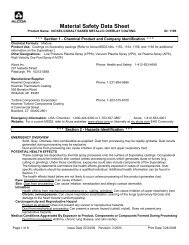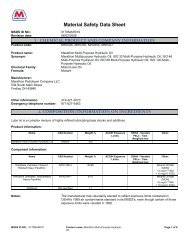SAFETY DATA SHEET
SAFETY DATA SHEET
SAFETY DATA SHEET
You also want an ePaper? Increase the reach of your titles
YUMPU automatically turns print PDFs into web optimized ePapers that Google loves.
Page: 3<br />
<strong>SAFETY</strong> <strong>DATA</strong> <strong>SHEET</strong> Revision Date: 09/09/2010<br />
Print Date: 9/13/2010<br />
PREMIUM CONVENTIONAL SAE 10W-40<br />
MOTOR OIL<br />
VV141<br />
MSDS Number: R0164091<br />
Version: 4.0<br />
Eyes<br />
If symptoms develop, move individual away from exposure and into fresh air. Flush eyes gently<br />
with water while holding eyelids apart. If symptoms persist or there is any visual difficulty, seek<br />
medical attention.<br />
Skin<br />
Remove contaminated clothing. Wash exposed area with soap and water. If symptoms persist,<br />
seek medical attention. Launder clothing before reuse.<br />
Ingestion<br />
Seek medical attention. If individual is drowsy or unconscious, do not give anything by mouth;<br />
place individual on the left side with the head down. Contact a physician, medical facility, or poison<br />
control center for advice about whether to induce vomiting. If possible, do not leave individual<br />
unattended.<br />
Inhalation<br />
If symptoms develop, move individual away from exposure and into fresh air. If symptoms<br />
persist, seek medical attention. If breathing is difficult, administer oxygen. Keep person warm and<br />
quiet; seek immediate medical attention.<br />
Notes to physician<br />
Hazards: Acute aspiration of large amounts of oil-laden material may produce a serious<br />
aspiration pneumonia. Patients who aspirate these oils should be followed for the development of longterm<br />
sequelae. Repeated aspiration of small quantities of mineral oil can produce chronic inflammation<br />
of the lungs (i.e. lipoid pneumonia) that may progress to pulmonary fibrosis. Symptoms are often subtle<br />
and radiological changes appear worse than clinical abnormalities. Occasionally, persistent cough,<br />
irritation of the upper respiratory tract, shortness of breath with exertion, fever, and bloody sputum<br />
occur. Inhalation exposure to oil mists below current workplace exposure limits is unlikely to cause<br />
pulmonary abnormalities.<br />
Treatment: No information available.<br />
5. FIRE-FIGHTING MEASURES<br />
Suitable extinguishing media<br />
Dry chemical, Carbon dioxide (CO2), Water spray<br />
Hazardous combustion products<br />
carbon dioxide and carbon monoxide, Hydrocarbons<br />
Page 3 / 11








